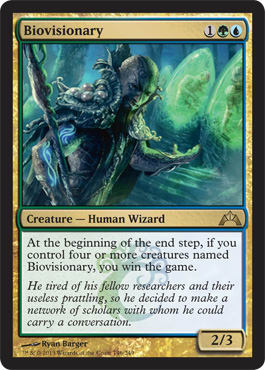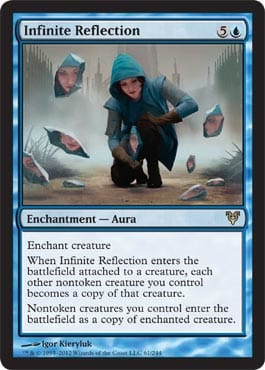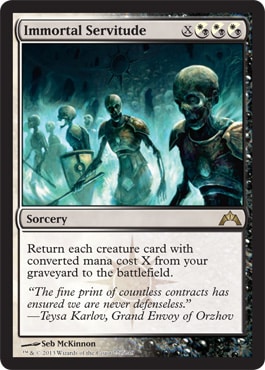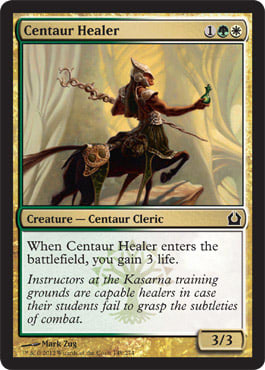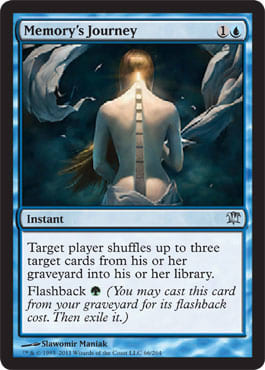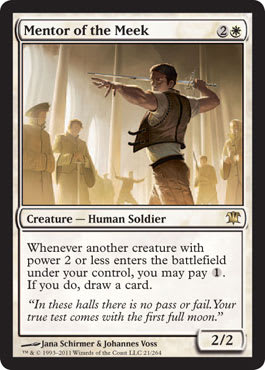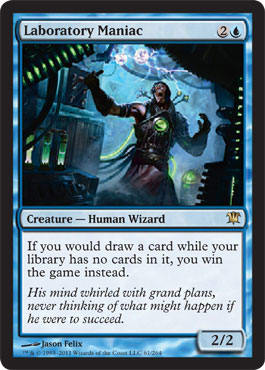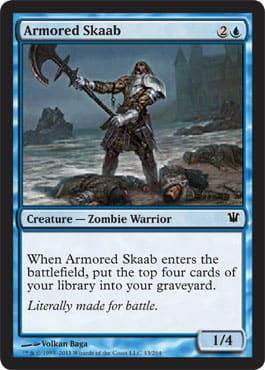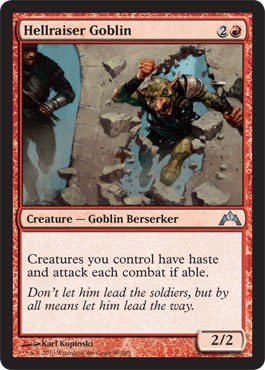Ooh, it’s Simic Week! Simic is my favorite guild, which means I should be super-excited to be here writing up a combo deck for the guild, right?
Well, it just so happens that I was so excited by the initial preview of Fathom Mage that I already wrote what would have made a perfect Simic Week article. That just means I’ll have to dig a little deeper this time.
And by “dig a little deeper,” I mean “go off-color.”
It Takes Vision
I’ve heard murmurs of Biovisionary since its Gatecrash release, and there are a lot of ways to make it happen. Various Clone effects are popular for achieving this Simic Wizard’s narcissistic dream, and even within Standard, we have Infinite Reflection. However, that Avacyn Restored Aura requires keeping a Biovisionary alive long enough to have the enchantment resolve on it. We’d also need three other nontoken creatures to go with it. That could be a fine direction for a player seeking to resolve a win-the-game trigger, especially in a Commander deck.
However, I have other plans. We’re not too far off from Innistrad—it’s still in Standard, after all—and several cards from that block happen to interact quite well with a particular Orzhov spell that can put four copies of Biovisionary onto the battlefield at one time.
If the Simic biomancers understand the need to combine various forces of nature—and Shambleshark and Experiment One will vouch they do—I think it’s reasonable that a forward-thinking scientist wouldn’t mind splicing together the powers of different guilds to brew a worthy concoction.
Orzhov
You may have guessed that the aforementioned Orzhov spell is Immortal Servitude. Like Biovisionary, this card has received its fair share of Johnny attention. The primary decision a deck-builder must make when considering this soul-summoning card is what will be the key mana cost. Modern decks running Martyr of Sands and Serra Ascendant might choose 1, and a Zombie deck of Gutter Skulks and Walking Corpses might choose 2, but with our Biovisionary plan, we’ll choose 3.
Of course, the new problem is having the creepy G/U Humans find their way into the graveyard from where they can enter their deathless service. Let’s take a look at another guild that can help us out with that.
Dimir
A 3-mana creature here that can help us put some cards into our graveyard is Sage's Row Denizen.
Oops!
This Vedalken is actually Gateless, as evidenced partially by the lack of the guild watermark, but pretty concretely by his unguilded garb.
Oh, and the flavor text:
Anyway, he seems to be a pretty good fit in Dimir, at least in terms of mechanics. We’ll see just how many cards this guy can mill in a bit.
Selesnya
Our hybrid Orzhov spell demands a choice: White, black, or both? Our Dimir card is mono-blue, which isn’t black, which means it doesn’t give us any direction. Knowing the deck will be green, blue, and either white or black, we have to figure out which of the two Orzhov colors will serve the deck better. Since I decided to keep this deck Standard, there weren’t any relevant 3-drops in black, whereas white has a couple spicy ones.
For the purposes of the Selesnya heading, I’ll mention Centaur Healer. This common is played in competitive Standard lists, is a 3-drop, and will help keep us alive while we’re setting up the graveyard. It also helps the beatdown plan if we happen to go that route.
Innistrad Humans
Okay, so now the guild headings are starting to become a little fuzzy. Oh well.
Humans on the plane of horror are all too well familiar with the graveyard, so they have a few tricks for dealing with such things. Tracker's Instincts are useful for hunting down specific creatures for specific in-game scenarios, and a Memory's Journey is a great thing to go on in search of demanding Immortal Servitude or preventing everlasting insanity.
I thought this guy was going to end up as an outlier, guildless and even planeless, wandering the multiverse with no heading to call his own. However, Borderland Ranger, a Magic 2010 original, was reprinted in Avacyn Restored, conveniently allowing him to reside comfortably between Kessig and Stensia. In our three-colored deck with deep white requirements and a desperate need for card advantage and strong effects, his skills are welcome.
Mentor of the Meek is the other white card that pulled the deck toward the Selesnya side of the Orzhov divide. This guy is a great card-advantage engine for the deck, as it has a ton of 2-power creatures. He can help dig deeper to put the right pieces into our hand instead of into our graveyard. To be honest, though, I really was just looking for some Merchant of Secrets variant in Standard. Why would I want my 3-mana creature to draw me a card when it enters the battlefield, you ask?
Innistrad Monsters
When we’re looking to 3-mana creatures with alternate win conditions, where better to look than at the weird-science master of Innistrad? We’ll be dumping our library into our graveyard, so what’s the downside of running this guy? We only need one of him, whereas we need four copies of Biovisionary, so he takes up less space in the deck, and with Merchant of Secrets, we can win directly off an Immortal Servitude—even if we haven’t emptied our library yet, but we’ll get to that yet. Unfortunately, we don’t have Merchant of Secrets, but that’s what Mentor of the Meek is for, though he’ll cost us 1 extra.
Laboratory Maniac straddles the line between Innistrad Humans and Innistrad monsters, but he seems much closer to the Skaaberen evil side than to the G/W good side. Still, though, he’s just a Human, so we need some real monsters to round out this heading.
Armored Skaab is a full-fledged Zombie (at least by Innistrad reckoning, and what better metric is there?), and it both mills our library and blocks effectively. Seems good.
Splinterfright happens to be the Innistrad rare I have the most copies of, and I’d call it speculating except that the only reason I have them is that I . . . just . . . kept . . . opening them. I might have picked up a few in Drafts as well. Regardless, these guys help our library shrink, and they can serve as massive blockers. I’ve also heard rumors about a thing in Magic called attacking, and these guys in conjunction with our 3/3 Centaurs for 3 make up win condition number three.
Simic
Fusing everything together, we end up with something decidedly Simic. (If you’re wondering who decided, it was I.)
"Immortal Vision"
- Creatures (27)
- 1 Laboratory Maniac
- 3 Borderland Ranger
- 3 Mentor of the Meek
- 4 Armored Skaab
- 4 Biovisionary
- 4 Centaur Healer
- 4 Sage's Row Denizen
- 4 Splinterfright
- Spells (9)
- 2 Memory's Journey
- 3 Immortal Servitude
- 4 Tracker's Instincts
- Lands (24)
- 3 Island
- 4 Plains
- 5 Forest
- 4 Glacial Fortress
- 4 Hinterland Harbor
- 4 Sunpetal Grove
Oh, the Possibilities!
All right, so this deck has a bunch of fancy pieces in it, but how does it actually play out? What about when we just mill all the copies of Immortal Servitude?
Well, in my testing with the deck, the copies of Memory's Journey proved more important than I had anticipated. Often, the combo will require seven or eight lands to go off fully, as we’ll need to cast Memory's Journey after one or more Splinterfright triggers leave us with an empty library but before our draw step. By shuffling in the three copies of Immortal Servitude or three redundant lands that happen to be the exact ones we need, we can make sure to draw the desired card that turn. However, we’re down 1 or 2 mana for the turn depending on whether the Journey was cast from our hand or flashed back, and we still need 6 for the Servitude and 1 more if we want to go for the instant win with Laboratory Maniac and Mentor of the Meek. Of course, ending the turn is almost as instant, so just foregoing that last mana and going for the Biovisionary plan seems fine as well.
Note that casting Immortal Servitude will kill any Splinterfrights either on the battlefield or having just arrived there. This isn’t a huge deal in the end game, but a midgame Servitude for value might not end up being that much value after all.
One of the most dynamic aspects of the deck, aside from any potential instant wins, of course, is just how many cards the deck can mill in one go with an Immortal Servitude and the right graveyard configuration. Imagine that we have one Sage's Row Denizen and two more in the graveyard along with a pair of Armored Skaabs and a Biovisionary. We cast Immortal Servitude, and this happens:
- Two Sage's Row Denizens, two Armored Skaabs, and a Biovisionary enter the battlefield. These are all blue creatures, so the Denizen that was already on the battlefield triggers five times.
- One of the Denizens that just entered triggers four times.
- The other graveyard Denizen also triggers four times.
- Two Armored Skaabs trigger.
Once it’s all resolved, we’ll have milled thirty-four cards—that’s primarily the work of the Sage's Row Denizen. Oh, and if any irrelevantly-colored Centaur Healers came for the ride, we’re up some life, too.
Anyway, you get the idea. When I assembled the list, I assumed the copies of Immortal Servitude would be precious resources, but with a drained library, Memory's Journey actually makes it pretty easy to grab one at the right time, so don’t be afraid to use one early (unless it’ll kill a Splinterfright you need!).
Until next time, I’m Andrew saying, “His mind whirled with grand plans, so he decided to make a network of Kessig into Stensia. Unless you come with me.”
Andrew Wilson
fissionessence at hotmail dot com
Gruul
This off-color, one-of guy is another one-card, 3-mana win condition. Just reanimate an army of 2- and 3-powered creatures, and immediately send them swinging to clean up the remains of any mess your Splinterfrights made!
Oh, the article’s over already? Oops.
















